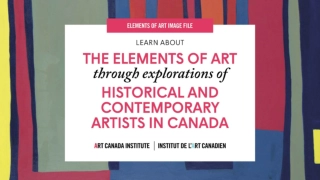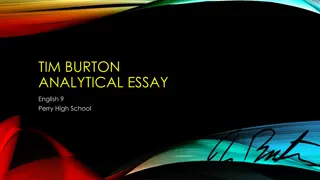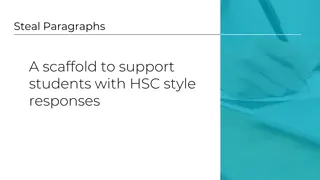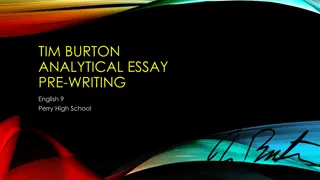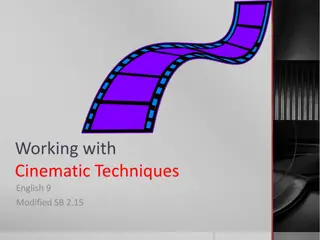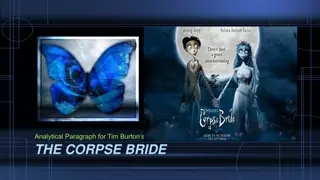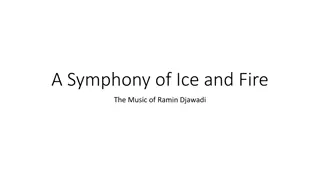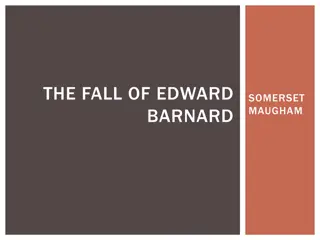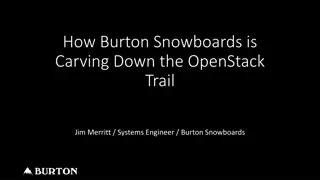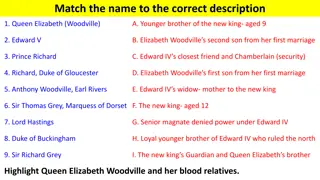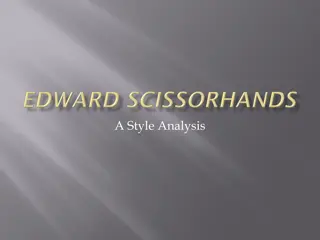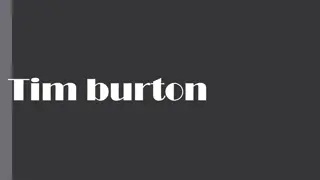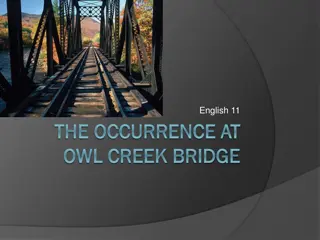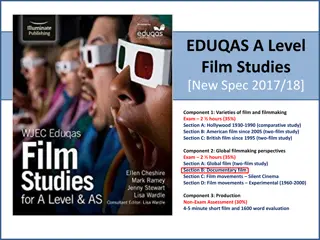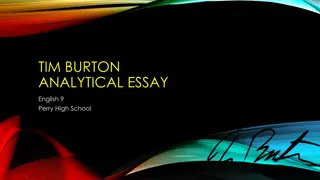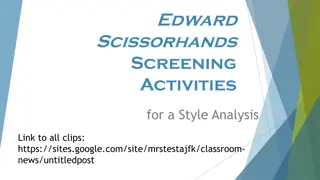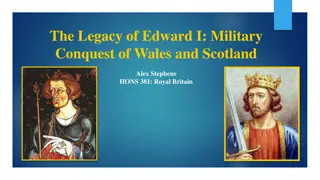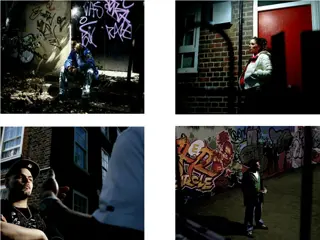Analyzing Cinematic Techniques in Tim Burton's Edward Scissorhands
This analysis dives into the use of cinematic elements, particularly long shots and angles, in Tim Burton's film "Edward Scissorhands." It explores how these techniques, such as making characters look vulnerable or stronger, contribute to the storytelling and overall style of Burton. Reflective commentary is added to provide insight into the impactful connection between cinematic choices and Burton's unique vision.
Download Presentation

Please find below an Image/Link to download the presentation.
The content on the website is provided AS IS for your information and personal use only. It may not be sold, licensed, or shared on other websites without obtaining consent from the author.If you encounter any issues during the download, it is possible that the publisher has removed the file from their server.
You are allowed to download the files provided on this website for personal or commercial use, subject to the condition that they are used lawfully. All files are the property of their respective owners.
The content on the website is provided AS IS for your information and personal use only. It may not be sold, licensed, or shared on other websites without obtaining consent from the author.
E N D
Presentation Transcript
Purpose: A purpose of a long shot is to make characters look vulnerable . Purpose: What is the purpose of the cinematic element? Writing an Analytical Statement: Writing an Analytical Statement: Tim Burton, in Edward Scissorhands, uses a long shot in order to show the vulnerability of characters. For example, when Peg is upstairs in the castle, the long shot makes Tim Burton, in Edward Scissorhands, uses ____________ (cinematic element) in order to _______________ (achieve what purpose). For example, ____________________ (evidence and effect combined). her look small so that the viewer worries about her safety. Effect: Peg looks very small in that big room. The long shot builds suspense because the viewer is worried about Peg. Example: When Peg is upstairs in the castle Examples: What are examples of where this cinematic element is used? Effect: What is the effect(s) of this cinematic choice?
We are now going to add the reflective commentary to your analytic statements. This is the elaboration/explanation element of your analytic statement. If the evidence is the WHAT, the reflective commentary is the SO WHAT? How does this cinematic technique connect to Burton s overall style?
Writing an Analytical Statement with Reflective Commentary: Tim Burton, in Edward Scissorhands, uses ____________ (cinematic element) in order to _______________ (achieve what purpose). For example, ____________________ (evidence and effect combined). _________________________________ ) reflective commentary Writing an Analytical Statement: Tim Burton, in Edward Scissorhands, uses a long shot in order to show the vulnerability of characters. For example, when Peg is upstairs in the castle, the long shot makes her look small so that the viewer worries about her safety. Reflective Commentary: By making viewers worry about Peg s safety, Burton is setting up Edward as a potential villain, increasing the intensity of the scene and revealing he is the anti-hero.
S/Analytical Statement: Tim Burton, in Edward Scissorhands, uses long shot (cinematic element) in order to make his characters seem more vulnerable (achieve what purpose). E: For example, when Peg enters the mansion, the long shot makes Peg seem vulnerable in such a large room which creates suspense (scene and effects of scene on mood/tone combined). E/Reflective Commentary: This mood is a trademark of Burton s overall quirky style and he uses shots and framing to enhance the viewers suspenseful experience (reflective commentary on overall style).
S/Analytical Statement: Tim Burton, in Edward Scissorhands, uses angles (cinematic element) in order to make his characters stronger or more powerful (achieve what purpose). E: For example, when the grandmother is telling her granddaughter the story, the camera zooms out to a high angle to show Edward s back to the audience as he looks down on the city giving him the appearance of him controlling the town in a way and striking fear into the audience s hearts (scene and effects of scene on mood/tone combined). E/Reflective Commentary: This is a trademark of Burton s overall style because he uses camera angles to entice the viewers and draw them in to make them wonder what will happen next (reflective commentary on overall style).
S/Analytical Statement: Tim Burton, in Edward Scissorhands, uses flashback(cinematic element) in order to cause the audience to connect deeper with the protagonist (achieve what purpose). E: For example, when the director shows a flashback to Edward s life with the inventor, the audience is touched to see that Edward is not a monster, but rather a living being with a past and a father figure (scene and effects of scene on mood/tone combined). E/Reflective Commentary: This connection is a trademark of Burton s overall style because he wants audiences to connect with the misfit protagonists in order to realize that people are all not so different from one another despite outward appearances (reflective commentary on overall style).
S/Analytical Statement: Tim Burton, in Corpse Bride, uses low key lighting (cinematic element) in order to change the audience s perception of good and evil (achieve what purpose). E: For example, the living world is always shown in low lighting with gray tones, pushing the audience to view this living world as a sinister, dreary place (scene and effects of scene on mood/tone combined). E/Reflective Commentary: This is a trademark of Burton s overall style because _________________________ (reflective commentary on overall style).
S/Analytical Statement: Tim Burton, in Corpse Bride, uses high key lighting (cinematic element) in order to change the audience s perception of good and evil (achieve what purpose). E: For example, ___________________ (scene and effects of scene on mood/tone combined). E/Reflective Commentary: This is a trademark of Burton s overall style because _________________________ (reflective commentary on overall style).
Attention grabber/hook Background information on themes/filmmaker Thesis: In _______, _______, and ________, director Tim Burton uses ____________ and _________________ in order to achieve his ____________ style.
Topic sentence that sets you up to discuss how Burton s purpose for, and use of cinematic technique #1 in each of the films reveals his style. Analytical Statement/SEE for Charlie and the Chocolate Factory Analytical Statement/SEE for Edward Scissorhands Analytical Statement/SEE for Corpse Bride Reflective Commentary that connects technique and purpose to Burton s overall style
Topic sentence that sets you up to discuss how Burton s purpose for, and use of cinematic technique #2 in each of the films reveals his style. Analytical Statement/SEE for Charlie and the Chocolate Factory Analytical Statement/SEE for Edward Scissorhands Analytical Statement/SEE for Corpse Bride Reflective Commentary that connects technique and purpose to Burton s overall style
Restate thesis in a slightly different and fresh way. Summarize a main point from each body paragraph in 2 4 sentences So what? Revisit your hook, but add your own further reflective commentary. Don t leave the reader asking, So what? Reflect on his style overall and its impact on his audience.


